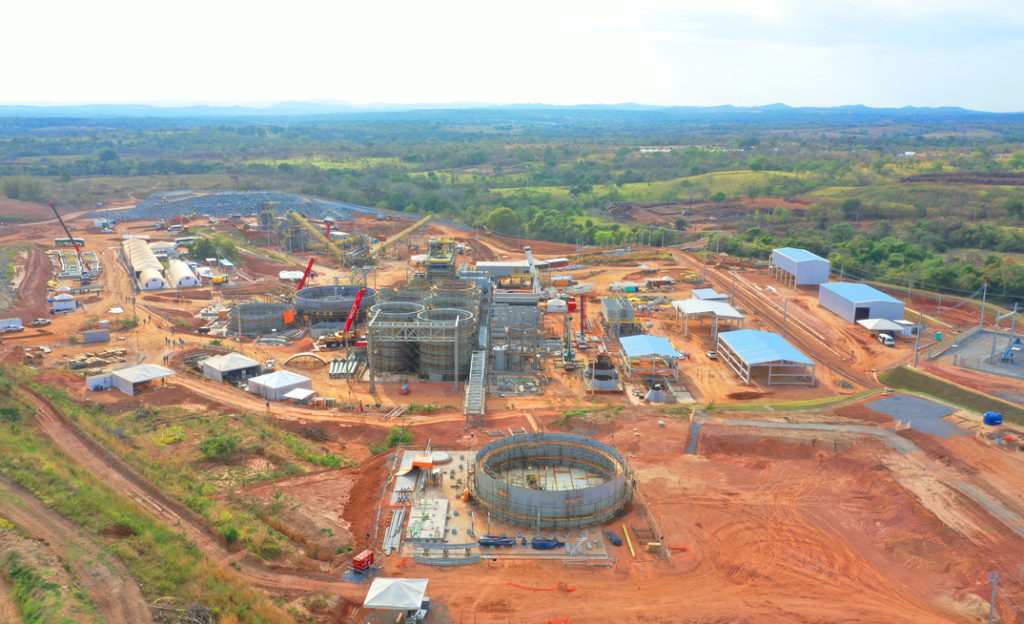Staff Writer | May 14, 2024 |

Hochschild’s new Mara Rosa mine in Goias, Brazil. Credit: Hochschild Mining
Hochschild Mining’s (LSE: HOC) Mara Rosa gold mine in Brazil has officially reached commercial production. The milestone was achieved ahead schedule, as its prior forecast was the end of second quarter.

In a news release Tuesday, the London-based miner said Mara Rosa, which made its first pour in February, is on track to produce somewhere between 83,000 and 93,000 ounces of gold for the calendar year. The mine, located in the state of Goias, is the company’s first Brazilian operation.
During the month of May, the Mara Rosa plant has operated at about 90% of its nameplate capacity of 7,000 tonnes per day and exceeded 80% average recoveries. Ramp-up is expected to continue, resulting in higher production during the second half of 2024.
“Achieving commercial production at Mara Rosa is a significant milestone for Hochschild and has been delivered ahead of our end H1 2024 forecast. This brings a new jurisdiction to the company and provides a springboard for further low-cost growth in Brazil,” Eduardo Landin, Hochschild’s CEO, stated.
Mara Rosa became a part of Hochschild’s portfolio through its C$135 million deal to buy Amarillo Gold in late 2021. At the time, the company cited the combination of low-cost and near-term production potential at Mara Rosa, and immediately began construction upon completing the acquisition.
Recently, Hochschild expanded its presence in Brazil by optioning the Monte Do Carmo project in Tocantins from Cerrado Gold (TSXV: CERT). A 2023 feasibility study on Monte Do Carmo outlined a nine-year mine that can produce 95,000 gold ounces annually.
Prior to entering Brazil, the miner had been focused on other jurisdictions in the Americas. It currently owns and operates the Inmaculada mine in southern Peru and has a 51% stake in the San Jose mine in Argentina. Both Inmaculada and San Jose are underground gold-silver mines that together produced nearly 220,000 oz. gold and 10 million oz. of silver last year. It also has the Pallancata operation in Peru that was put on care and maintenance late 2024.
Troilus Gold shares fall on Quebec project feasibility study
Troilus Gold (TSX: TLG) shares fell after releasing a feasibility study that outlined a 22-year open-pit operation in north-central Quebec that would produce 5.4 million oz. of gold, 382 million lb. of copper and 9.9 million oz. of silver over that span.
Average annual production of payable metal is 244,600 oz. of gold, 17.3 million lb. of copper and 446,700 oz. of silver, peaking at 456,100 oz. gold, 31.8 million lb. copper and 613,600 oz. silver in year 7.
The Troilus project has an estimated net present value (discounted at 5%) of $884.5 million and an internal rate of return of 14%, reflecting long-term forecast prices of $1,975/oz. gold, $4.05/lb. copper and $23/oz. silver.
Using current (April 2024 average) metal prices of $2,332/oz. gold, $4.30/lb. copper and $27.50/oz. silver, the after-tax NPV and IRR would rise to $1.55 billion and 19.5% respectively.
Initial development capital is projected at $1.07 billion, including all mine pre-production costs, net of existing infrastructure. The payback period is 5.7 years, based on cumulative after-tax cashflows of $2.2 billion.
Justin Reid, CEO of Troilus, said the FS outlines a “generational-scale asset” with compelling economics, both at discounted and current metal prices, highlighted by a reasonable capex and capital intensity, including bottom quartile operating costs among the major Canadian gold mines.
However, shares of Troilus Gold fell 15.2% to C$0.56 by 11:30 a.m. ET following the feasibility study release, for a market capitalization of C$155.5 million ($114m).
With the feasibility study complete, Troilus will now move towards the project’s environmental and social impact assessment, which it hopes to complete by the end of this year. Also in progress are the provincial and federal permitting processes, which it began in May 2022.
Concurrently, Troilus will focus on exploration of the 435 km² property. Numerous targets ranging from grassroots geochemical anomalies to early-stage drill targets are actively being explored, and the company believes “there is strong potential to further expand the scale of this project and extend the mine life beyond the 22 years.”
The proposed open-pit mine will have a processing capacity of 50,000 tonnes per day, a 43% increase on the 35,000 tpd contemplated in the 2020 preliminary economic assessment.
Mining will occur from four main zones of mineralization that together hold 380 million tonnes in mineral reserves grading 0.49 g/t gold, 0.058% copper and 1.0 g/t silver, containing 6.02 million oz. gold, 484 million lb. copper and 12.15 million oz. silver.
No comments:
Post a Comment